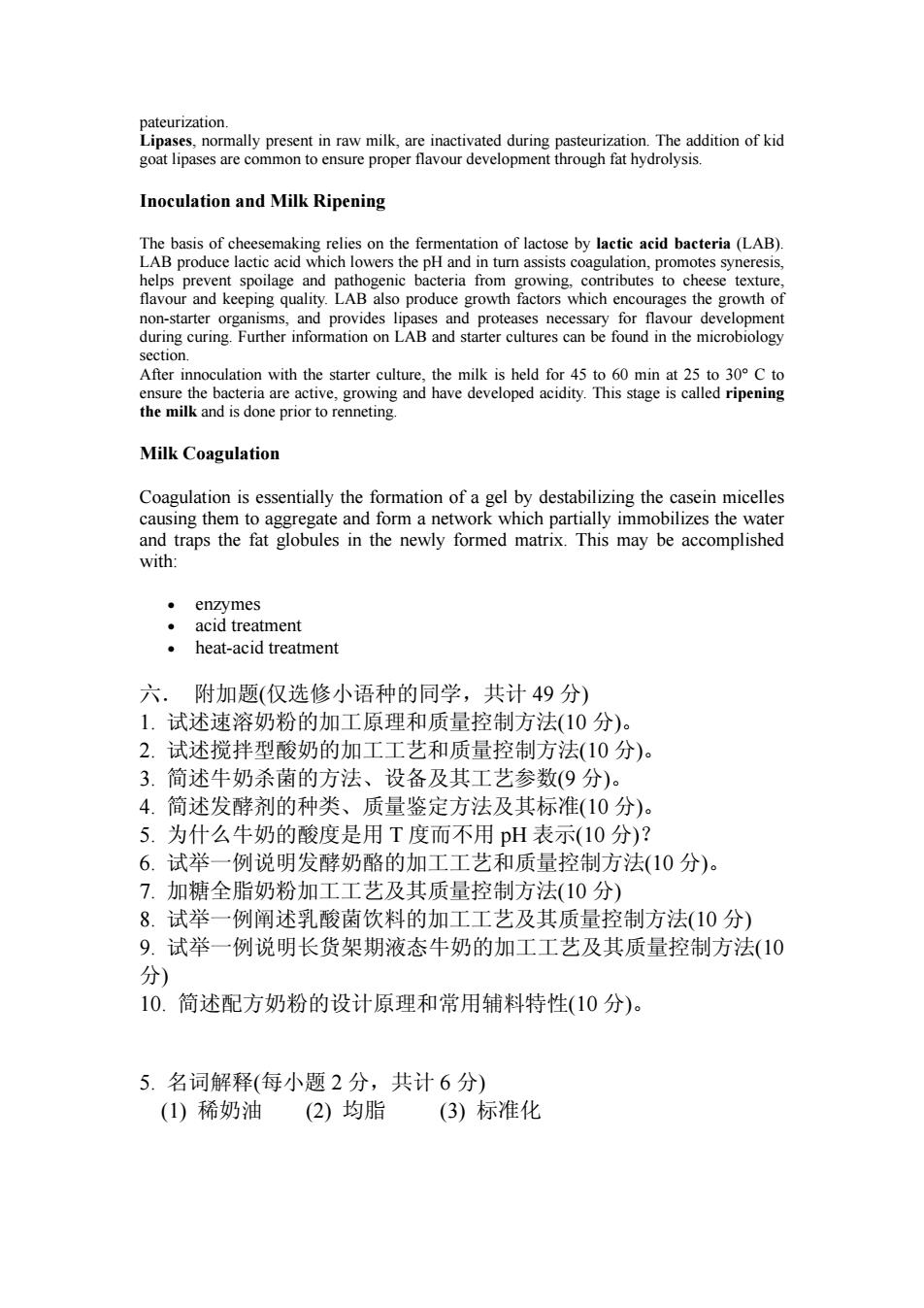正在加载图片...

pateurization. Inoculation and Milk Ripening helps prevent spoilage and pathogenic bacteria fo rowing contributes to cheese texture flavour and keeping quality.LAB also produce growth factors which enco rages the growth o section the milk and is done prior to renneting Milk Coagulation Coagulation is essentially the formation of a gel by destabilizing the casein micelles sing th orm a network whic ly imme ilizes the w atment heat-acid treatment 六.附加题(仅选修小语种的同学,共计49分) 1.试述速溶奶粉的加工原理和质量控制方法(10分)。 2.试述搅拌型酸奶的加工工艺和质量控制方法(10分) 3.简述牛奶杀菌的方法、设备及其工艺参数(9分)。 4.简述发酵剂的种类、质量鉴定方法及其标准(10分) 5.为什么牛奶的酸度是用T度而不用pH表示(10分)? 6.试举一例说明发酵奶酪的加工工艺和质量控制方法(10分)。 7.加糖全脂奶粉加工工艺及其质量控制方法(10分) 8.试举一例阐述乳酸菌饮料的加工工艺及其质量控制方法(10分) 9.试举一例说明长货架期液态牛奶的加工工艺及其质量控制方法(10 分分) 10.简述配方奶粉的设计原理和常用辅料特性(10分)。 5.名词解释(每小题2分,共计6分) (1)稀奶油(2)均脂(3)标准化 pateurization. Lipases, normally present in raw milk, are inactivated during pasteurization. The addition of kid goat lipases are common to ensure proper flavour development through fat hydrolysis. Inoculation and Milk Ripening The basis of cheesemaking relies on the fermentation of lactose by lactic acid bacteria (LAB). LAB produce lactic acid which lowers the pH and in turn assists coagulation, promotes syneresis, helps prevent spoilage and pathogenic bacteria from growing, contributes to cheese texture, flavour and keeping quality. LAB also produce growth factors which encourages the growth of non-starter organisms, and provides lipases and proteases necessary for flavour development during curing. Further information on LAB and starter cultures can be found in the microbiology section. After innoculation with the starter culture, the milk is held for 45 to 60 min at 25 to 30° C to ensure the bacteria are active, growing and have developed acidity. This stage is called ripening the milk and is done prior to renneting. Milk Coagulation Coagulation is essentially the formation of a gel by destabilizing the casein micelles causing them to aggregate and form a network which partially immobilizes the water and traps the fat globules in the newly formed matrix. This may be accomplished with: • enzymes • acid treatment • heat-acid treatment 六. 附加题(仅选修小语种的同学,共计 49 分) 1. 试述速溶奶粉的加工原理和质量控制方法(10 分)。 2. 试述搅拌型酸奶的加工工艺和质量控制方法(10 分)。 3. 简述牛奶杀菌的方法、设备及其工艺参数(9 分)。 4. 简述发酵剂的种类、质量鉴定方法及其标准(10 分)。 5. 为什么牛奶的酸度是用 T 度而不用 pH 表示(10 分)? 6. 试举一例说明发酵奶酪的加工工艺和质量控制方法(10 分)。 7. 加糖全脂奶粉加工工艺及其质量控制方法(10 分) 8. 试举一例阐述乳酸菌饮料的加工工艺及其质量控制方法(10 分) 9. 试举一例说明长货架期液态牛奶的加工工艺及其质量控制方法(10 分) 10. 简述配方奶粉的设计原理和常用辅料特性(10 分)。 5. 名词解释(每小题 2 分,共计 6 分) (1) 稀奶油 (2) 均脂 (3) 标准化